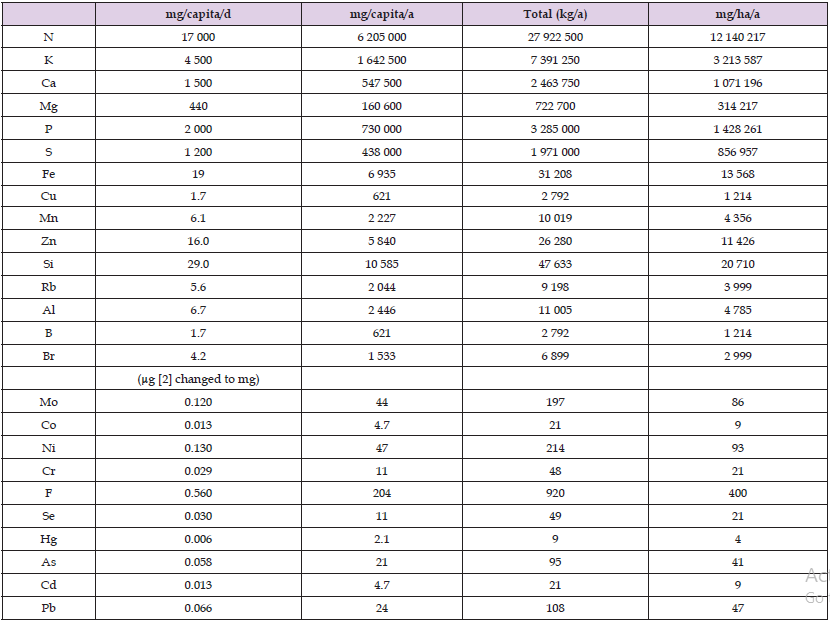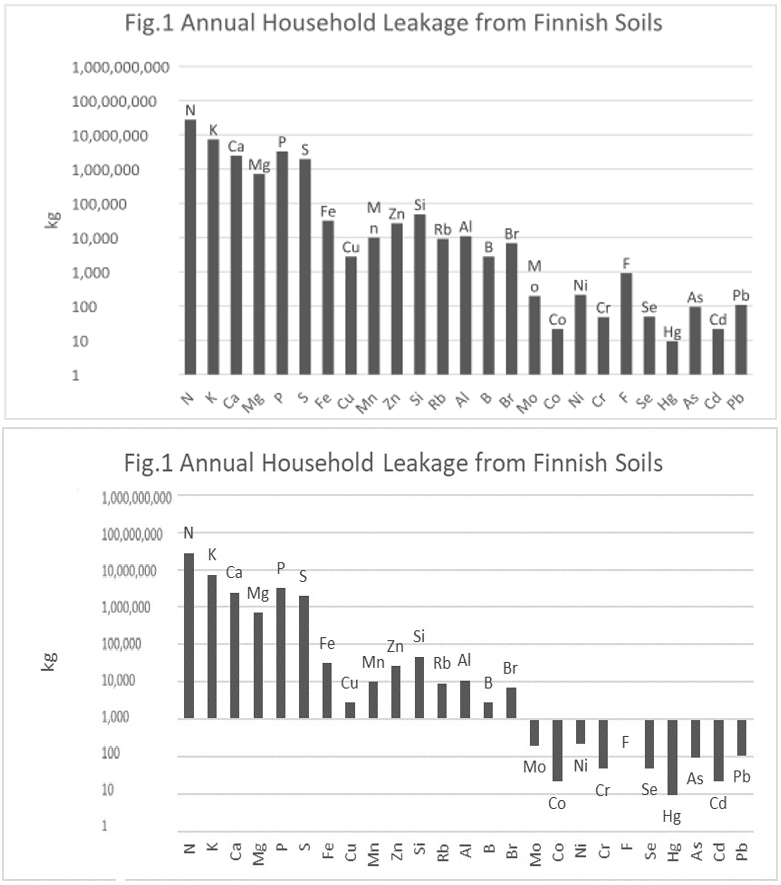Impact Factor : 0.548
- NLM ID: 101723284
- OCoLC: 999826537
- LCCN: 2017202541
Timo Töysä*
Received: June 29, 2024; Published: August 05, 2024
*Corresponding author: Töysa T, Licentiate of Medicine, Specialty General Practice, Kuopio, Eastern Finland
DOI: 10.26717/BJSTR.2024.58.009089
Abbreviations: AADS: Average Available Daily Supply (/Supplies) and Estimate of Potential Soil Supply
An evaluation of the “average available daily supplies” (AADS) of 15 mineral elements (in the title) from Finnish foods (per “capita”, i.e. per 10 MJ [1] has been carried out in 1975-1978 [2]. AADS’s have been benefited as estimates of human intake (input), as well as output with the same label (AADS) as potential measures of their ability to replace the losses. If recovery of the mineral elements of human nutrients in Finland had been ca 100 %, in 1950-2020, it had produced ca 70 x 365, i.e. 26 000 x the “average available daily supply” of each element. By Finnish population, estimated population for calculations 4.5 million (based on 4.0 million in 1950 and 5.5 million in 2020 [3]), it had made up 26 000 x 4 500 000, i.e. 115 billion times the “available daily supply. A part of the mineral loss was replaced via import from the soils of foreign countries, but this has been roughly balanced by the Finnish agricultural nutrients exported to other countries.
The mean cultivated agricultural area, used for calculations, was ca 2.3 million ha (2.4 in 1950 and 2.2 million ha in 2020 [4]). In Table 1 are represented the fertilizing potential of AADS’s by each element in agricultural soils by daily amounts (mg/capita/d) and annual amounts (mg/capita/a and Total (kg/a)) and annual amounts per hectare (mg/ha/a) (Table 1). The mineral element content of the agricultural products has decreased during the last century. In a study based on data from the 1930’s and 1980’s the average contents showed a general decreasing trend, but not by P [5]. The (geometric mean of) Mg and Cu decreased significantly in vegetables as well as in fruits - by Cu contents in vegetables ca 80 %.
Table 1: The potential of human mineral element supply (approximated by AADS) in Finland in the 1970’s and higher estimate for their agricultural losses. (calculated per 10 MJ [2], 2.7 kWh, 2390 kcal).

The idea that the terrestrial nature is a totality of urban and rural ecosystems, has been discovered during the last decades (e.g. [6]) and the benefiting of the communal sludge for agricultural use is increased in Finland during the last years up to 40 % [7].
Daily AADS doses can work as the first coarse “normal”, “tolerable” or “sufficient” reference values (because Finns were alive after such doses) for macro- and microelements. Anyhow several warnings were detected in 1980 [2]: first exceptionally high Ca/Mg ratio, secondly very high Ca and P intake and their possible effects on the metabolism of Mg, Fe, Cu, Mn and Zn and e.g. low level of Se intake. Microelements can contain several secrets, (generally) unknown properties and interactions, e.g. Cu is often seen as a pollutant, “heavy metal” (without references of recommended ranges) although Cu deficiency of soil has required to be treated at least since the 1950’s [8]. Normal range of plant available (DTPA-extractable) Cu in soil: 4 – 20 ppm (ca 30 % of total Cu) [9], approximately ca 8 – 50 kg/ha (by plough layer 25 cm and soil volume weight ca 1 kg/l). Daily Cu AADS seems not be great (1.7 mg), but its annual potential (ca 3 000 kg in Finland) shows its importance.
Although ca 40 % of the wastewater is treated in sewage treatment plants for agricultural use [7], the recovery of the AADS mineral elements (and carbon) is obviously remarkably lower, because the treatments take their proportions. [Figure 1]
Figure 1: This figure shows approximate Finnish household leakage of soil minerals in the 1970’s (without replacements).

It is suggested that the (non-defined) disbalance in mineral elements of Finnish soils (and refined foods) could explain the increased number of cases of allergy in Finland, oppositely to East Karelia (Russia) [10], with active garden cultivation, obviously associated with effective recycling. Active garden cultivation has obviously not only retained better soil balance of mineral elements, but additionally increased supply of mineral elements of soil silicates and increased their (e.g. Si) content in food [11]. Possibly the difference in mineral element balance can be associated with better non-specific immune protection e.g. via Cu [9] or even nickel (Wikipedia) and management of inflammation e.g. via Superoxide Dismutase’s (Wikipedia), which could explain the surprisingly weak or strong protection against COVID-19 and “vaccine responses” of “Long COVID” (Wikipedia), too. “The most important protection against infectious diseases is the normal function of a healthy cell” [12].


